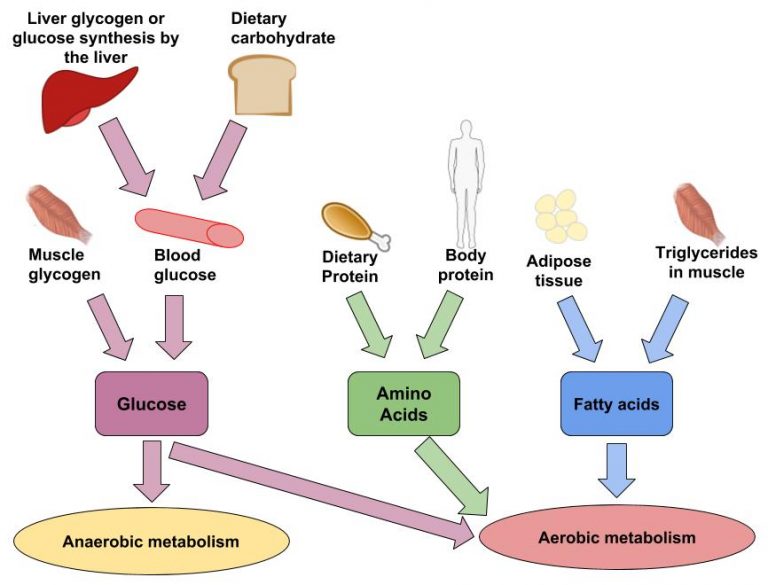17.1.3: How Do the Macronutrients Provide ATP?
- Page ID
- 39236
Major metabolic pathways that macronutrients follow to produce ATP.
After the energy-containing nutrients have been absorbed through the small intestine, they can enter a metabolic pathway and be converted to energy or be stored as fat for later use. These three macronutrients —carbohydrates, proteins, and fats— fuel the production of ATP by entering the pathway at some point in the stages of energy metabolism. Their fate is determined by the chemical reactions within each metabolic pathway (see figure 9.1.3.1). The major energy nutrient, which is glucose, fuels metabolism from the first stage through the final stage.1 As you learned in the previous segments, several amino acids can be converted into glucose and fats (or better 'triglycerides') are broken down into fatty acids and glycerol, which then contribute to energy generation as they are transformed into different substrates along the pathway.

Figure 9.1.3.1 Fuel Sources for Anaerobic and Aerobic Metabolism, and metabolic fate of the three energy-containing macronutrients: carbohydrates, proteins, and fats.2
Please remember from section 9.1, figure 9.1 that food is converted into cellular energy as ATP in three stages:
- Stage 1 of the metabolic fate of food includes glucose, glucogenic amino acids and glycerol to enter the anaerobic pathway glycolysis pathway to produce pyruvate.
- Stage 2 of the energy pathway includes the conversion of glucose, ketogenic amino acids and fatty acids to be converted into Acetyl-CoA.
- In stage 3 of the energy pathway, Acetyl-CoA enters into the Krebs Cycle (which then leads to the Electron Transport Chain to generate ATP).
Carbohydrates are unique in that they are oxidized anaerobically in stages 1 and 2 of metabolism and also aerobically in stage 3. Fatty acids derived from triglycerides are only oxidized aerobically in stage 2; this process is slower than anaerobic metabolism and hence only executed when enough oxygen is available. The fatty acids are split from the glycerol backbone before they are metabolized and converted to acetyl CoA, whereas glycerol enters metabolism through glycolysis.1
When amino acids from proteins are needed for energy, the structure of their side group determines where they enter the metabolic pathway: glucogenic amino acids can be transformed into glucose through gluconeogenesis when carbohydrate intake is low. They can also be converted to substrates and enter glycolysis in stage 1. Ketogenic amino acids (keto=ketone, genic=forming) can be converted to acetyl CoA in stage 2, while a few other amino acids can be converted to intermediate substrates in the Krebs Cycle in stage 3.1
Definition: ketogenic -- molecules that can be transformed into ketone bodies.1
In the next segment, we are looking at the transformation of glucose to pyruvate during glycolysis .
Check your knowledge:
True or False: Glucogenic amino acids, glycogen, and glycerol can enter into anaerobic glycolysis at specific pathways to produce pyruvate.
True or False: Cells use ATP to provide energy for metabolic reactions.
Contributors
References & Links
- Blake, J. S., Munoz, K. D., & Volpe, S. (2019). Nutrition: From Science to You (4th ed.). Pearson.
- https://med.libretexts.org/Under_Con...A_Fuel_Sources
- Gropper SS, Smith JL, Groff JL. (2016) Advanced nutrition and human metabolism (7th ed.). Cengage.

